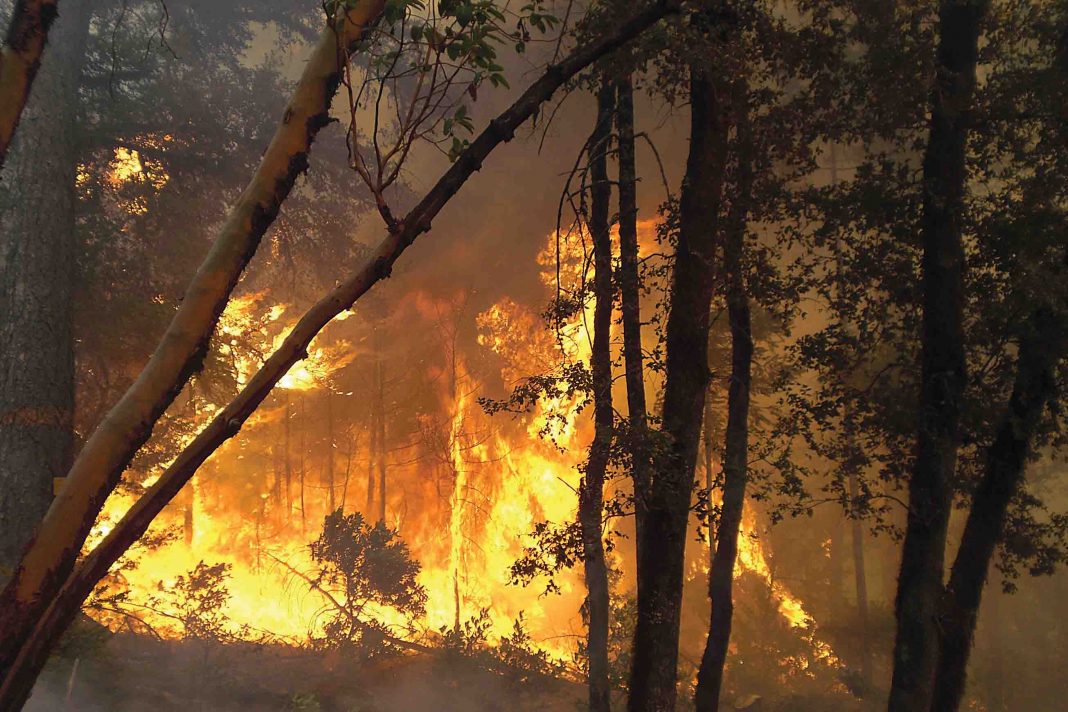By Charles Sanders
There are many things rural homeowners can do to mitigate the danger of wildfires. The first is to create a defensive zone around your home site which will become a buffer area around it that will greatly increase the odds of your home surviving a wildfire. The buffer area will slow or even stop the spread of the wildfire.
- First, remove dead vegetation, leaves, pine needles, and other debris from around your home’s foundation, gutters, and drainage areas. Extend this clearing out to about 30 feet or so from your buildings. Don’t forget to clear debris from under porches or decks where the wind tends to pile things up.
- Keep brush cleared from within a hundred feet of your home.
- Clear “ladder fuels” from trees around your property. Ladder fuels are limbs that are 6-10 feet from the ground. Once the fuels that are close to the ground ignite, the flames can climb into the adjacent trees as if on a ladder, hence the term. Removing low growing vegetation and pruning low limbs ahead of time can help prevent explosive fires occurring in the trees themselves. Those of you who have witnessed a tree catching fire in such a manner know that it can happen with frightening quickness. In drought-ridden areas, a mature tree a hundred feet tall can explode into flames in a matter of seconds. It’s scary.
- If shrubs are growing near trees, have clear space to the lowest limbs of the trees equal to three times the height of the shrub or bush.
- Keep tree branches trimmed back to maintain at least 10 feet between trees.
- Remove any tree branches that overhang your roof.
- Don’t stack fuels such as firewood or straw alongside your home or outbuildings.
- Move any woodpiles or other flammable materials to at least 100 feet from your home.
- Position LP fuel tanks away from your home. Large tanks should already be a safe distance away, but remove smaller tanks, including the one on your gas grill, and move it away from the house.
- Keep your grass mowed. Tall grass, especially in dry times, can burn hot and fast.
- Have water spigots available at convenient points around your homesite.
- Have plenty of hose (and a few extras) to deploy in the event of a wildfire.
- If you have a home water system, be sure that it has sufficient pressure to provide water to several areas around the homesite if needed.
- Consider having rooftop sprinklers available to connect hoses to.
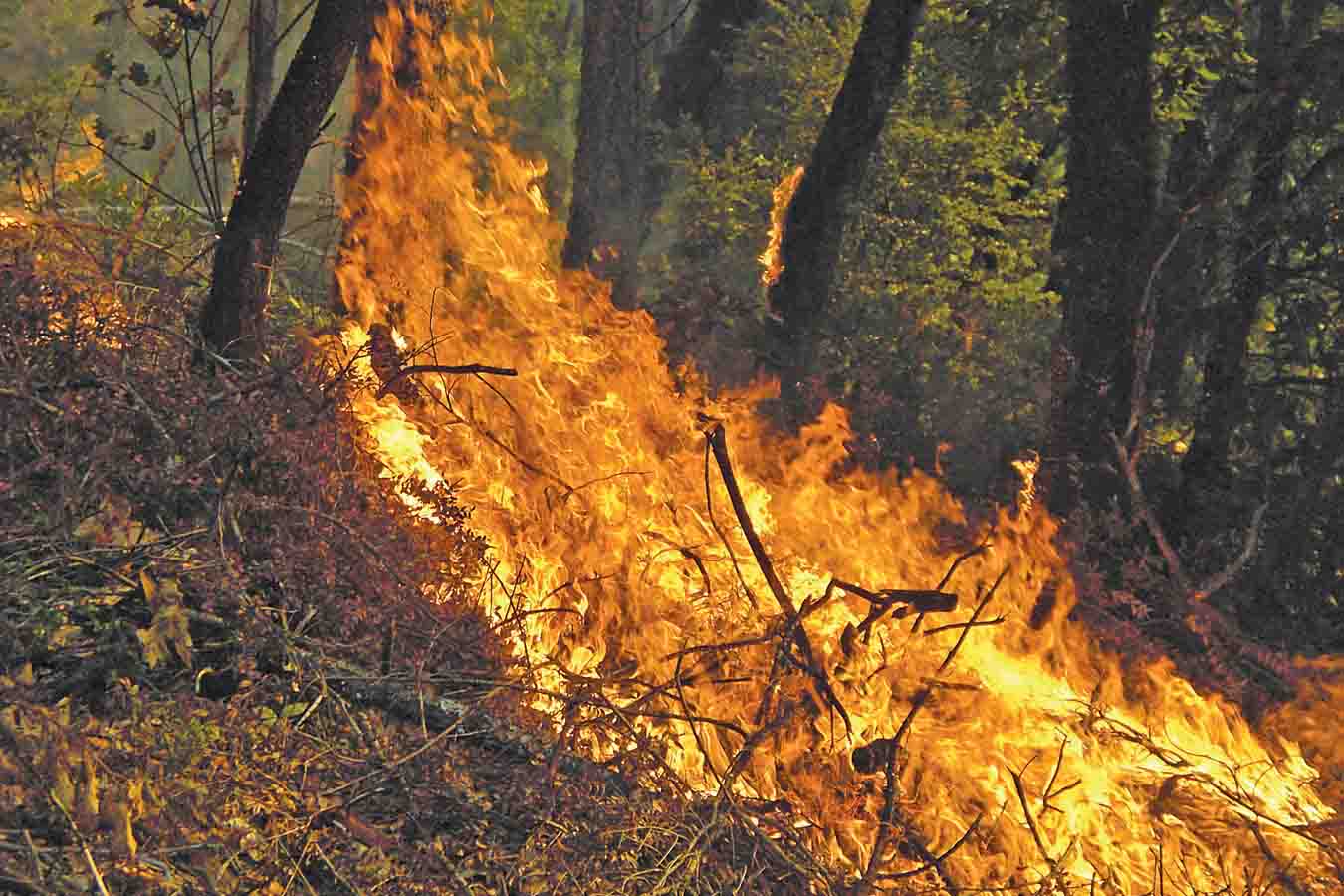
Removing shrubs and debris as well as trimming the lower branches on trees can help to keep the fire from climbing the trees.
As you consider these guidelines to help secure your homestead against wildfire, be sure to check for any local regulations that might also apply. Some areas may have more stringent guidelines, requirements, and restrictions.
Along with folks moving into more natural settings is the desire to build a home that blends in and is made from natural materials. If you are building anew in fire country, consider designs that incorporate fire-resistant materials. “Barndominiums” are growing in popularity and are often constructed using ribbed metal for not only the roofs, but for siding as well. Additionally, there are several companies that offer metal roofing that resembles ordinary shingles. I have seen several of these and can say that they are hard to tell from more common asphalt or fiberglass shingles. They are attractive and fireproof.
Have plenty of access to water in your new place. A water spigot or hydrant near each exterior corner of your home and a few near outbuildings, gardens, and so forth can offer additional protection. Have hoses available for each water source.
If you have a pond, you might even want to invest in a gasoline-powered water pump. I have used many of these over the years while on wildfire crews and can tell you that they can move a lot of water in a hurry. They can be purchased for several hundred dollars.

The council rake, or fire rake, is a real help in scratching in a fire line. It has replaceable teeth and is a favorite handtool of frontline firefighters. Photo courtesy of The Supply Cache.

The Pulaski axe is a versatile handtool for firefighting. It has an axe head on one side and a mattock for digging and grubbing on the other. Photo courtesy of The Supply Cache.
Another important consideration may not even come from the fuels around your own place. Wind blown embers can carry for a mile or more and can cause a wildfire to spread exponentially. In fact, most homes and other structures are not destroyed by a direct flame front, but are ignited by embers carried on the winds that are often created by the magnitude of the fire itself. Those embers can lie in leaf-covered landscaping, on moss covered shingles, or in leaf-filled gutters and just smolder until they gain enough life to burst into flame.
To help prevent your home from falling victim to wind blown embers, consider constructing or renovating your home with a roof of metal, slate, or other non-combustible material.
Rooftop sprinkler systems are also available that can help to wet down your roof and home and further reduce the likelihood of ignition by wildfire.
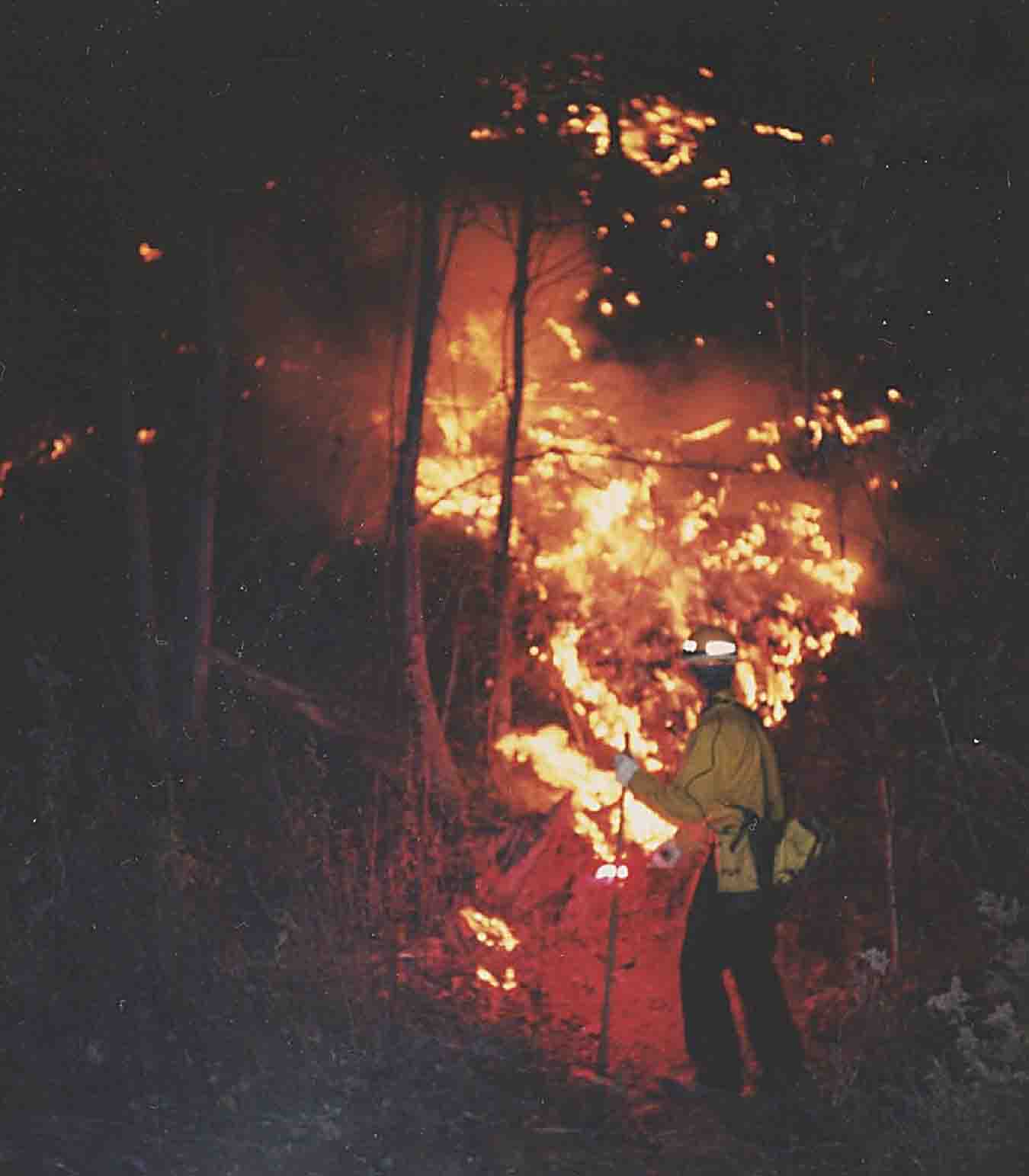
A wildland firefighter working the fireline at night
Fire tools
It’s a good idea to have a few basic fire fighting tools on hand around your place. While designed for wildland fire fighting, you’ll likely find them useful in other applications as well. For our purposes here, I’ll make a couple of recommendations for helping keep a fire at bay on your place.
First is the Pulaski axe. This tool has an axe head on one side for chopping and a mattock blade for digging and grubbing on the other. It is a very versatile tool.
The second tool I’d recommend is the fire rake or council rake. The simple design of this tool and its effectiveness in scratching out a fire line make it an important tool for fire fighters. The long handle makes it comfortable to use for long periods of time. The replaceable mower blade teeth make it a long lasting implement.
With these two simple handtools, and perhaps a pointed shovel, a few people can quickly cut an effective fireline in most terrain. Similarly, homeowners can use them to quickly clear out brush, shrubs, and other vegetation, and help to provide another layer of safety for your home.
In addition, you may wish to contact your local fire department or state department of forestry for information on basic firefighter training.
The fire is burning
Suppose your general area has an active wildfire burning. It’s not yet an all-out evacuation, but you need to do some things to help prepare as fires approach or as conditions worsen.
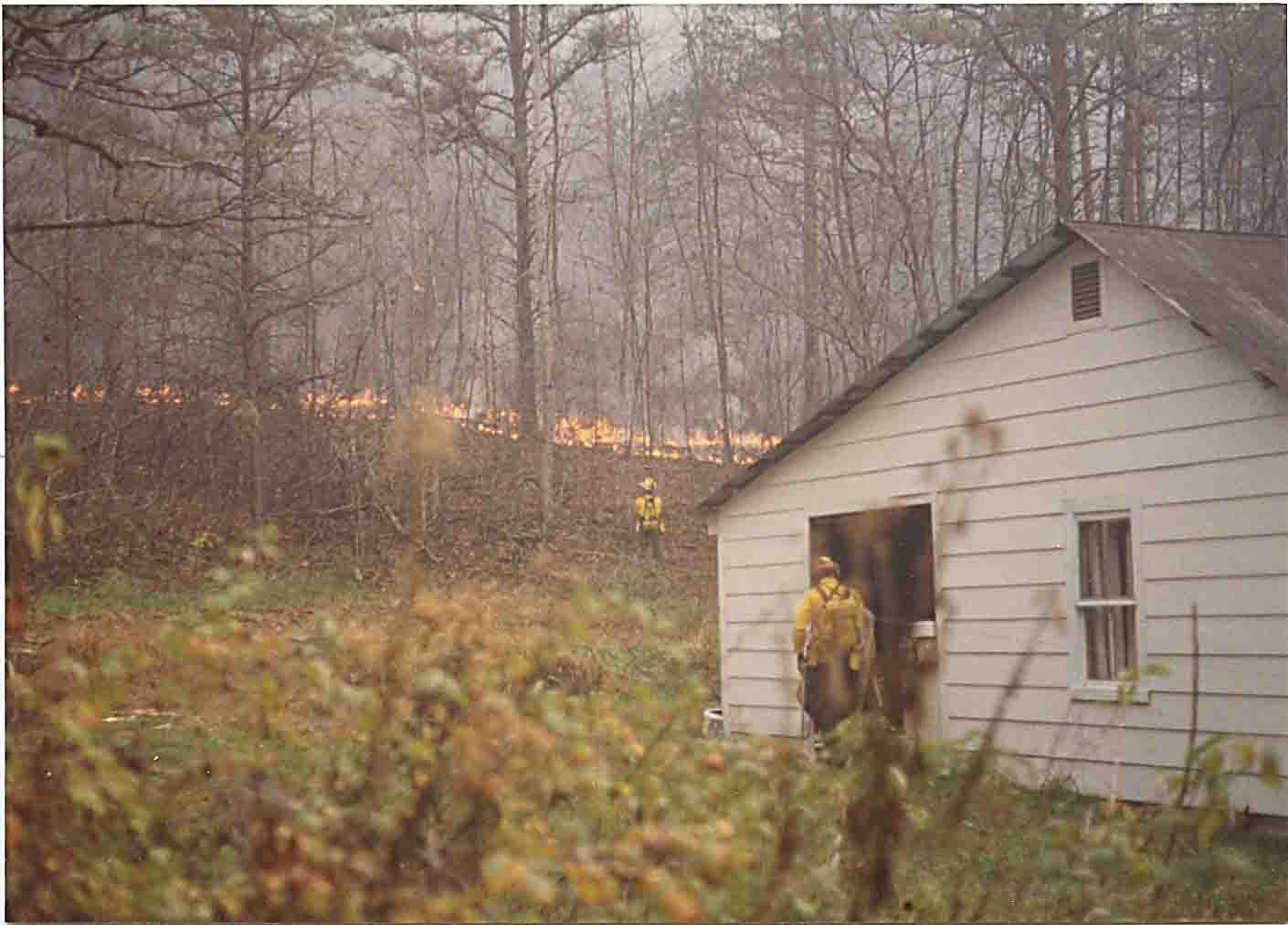
Here we monitor a creeping fire around a residence in rural Kentucky.
Outside your home
Move any flammable items away from the house. Move them into a garage or shed. In a pinch, place them in an open area well away from the house or other outbuildings.
Turn off any propane tanks. If you have natural gas, shut off the gas at the meter.
As an aid to firefighters, have hoses hooked to any outside spigots or hydrants.
Wildfires are very volatile and respond quickly to the whims of wind, weather, terrain, and fuel types. A fire that is merely creeping along can blow up into a raging inferno in a frighteningly short period of time. Many times, these periods of high fire activity come in the afternoon hours when temperature rise, humidity decreases, and winds pick up.
If you are in a fire area and are monitoring an active fire, things may quickly deteriorate to the point that evacuation may be necessary.
In most cases, a wildfire simply isn’t something you can hunker down and survive. It takes preparation, knowledge, and a willingness to know when to evacuate.
Here are some life-saving tips:
- Listen to local authorities
- Respond to evacuation orders.
- Have a good grab ‘n’ go kit ready to go. Don’t wait until the last minute to try to grab things and put it together. Have a kit ready (see the many other sources available of ideas on what to include in your kit).
- As the situation develops or worsens, have other items ready to grab and go.
- Of course, persons, pets, and livestock have priority over any property. Make sure everyone in your family is present and accounted for. Grab the pets. In some cases, you may only have time to turn the livestock out to fend for themselves and hope for the best. Such are the stark realities of wildland living.
Here is a good basic list for assembling an emergency kit:
Three-day emergency kit
- Three days of food and three gallons of water per person.
- Credit or debit cards, checkbooks, and cash
- Prescription medications
- Identification and photographs of each family member
- A good map with primary and secondary evacuation routes marked. Family assembly points should also be noted.
- Clothing for a couple of days
- Flashlight
- Radio with extra batteries
- Important documents (birth certificates, passports, etc.)
- First Aid Kit
- Extra eyeglasses/contact lenses
- Laptop or personal computer with important information (if you have time)
- Thumbdrives with important information
- Important family mementos such as photographs or other irreplaceable items
- Contact information and documents for utilities and insurance
- Chargers for cell phones, laptop, flashlights, etc.
- Easily carried valuables
- Other portable items that you deem important
Remember that regardless of an item’s value, either actual or sentimental, it can be replaced. Your life cannot. Do not jeopardize your survival in an effort to pack or carry too many personal belongings as you evacuate.
The website http://www.ready.gov has more information on emergency kits and evacuation plans.
Evacuation plan
Here are some pointers to get you started in preparing an evacuation plan:
- Evacuation Routes — primary and backup. Have alternate routes already in place, in case your primary routes are blocked or clogged with traffic or fire fighting equipment.
- Destinations — primary and secondary. Have a backup, in case evacuation routes are blocked, or other hazards exist.
- Communications — discuss plans in advance with immediate family and others.
Have primary and secondary meet-up points. Every person in the family should know of the destinations in advance. Make sure each family member knows where to go in the event an evacuation order is in place.
Try to have persons at those destinations who know to expect you, that they know you will be coming there.
Remember that communications may be disrupted. Cell service may be non-existent or overloaded with people trying to communicate.
- Methods — Automobile? Shanks’ mare (walking)?
- Comply with emergency officials. Emergency Operations Plans are in place in nearly every part of the country for situations like wildfires. First responders, law enforcement, and fire personnel should know where to send you and how to help you evacuate. Rely on their experience and training.
- Don’t wait until the last minute to evacuate. Fire conditions can change very rapidly. Routes that might have been declared safe can be overrun quickly.
When firefighters respond to your site, be sure they know where resources such as ponds are located. Advise them of any potential dangers such as LP gas tanks, liquid fuel storage tanks or buildings, electrical transformers, and so forth. They are trained to look for such potential dangers, but it can save time if you can let them know immediately.
If an evacuation order comes down, you may, at first, be reluctant to comply. It’s difficult to leave your home, your belongings, and property. However, material things can be replaced. If you have already placed important documents, records, and other vital papers in your evacuation kit, know that all of the “stuff” you leave behind can be replaced and is not worth risking your life for.
During
Ok, you’ve been told that an evacuation order is in place. You no longer have the option whether to stay. You’ve grabbed your grab ‘n’ go bag, your communication plan is known to other family members, you’ve loaded your vehicle, and you’re ready to go. As you prepare to evacuate, have a simple checklist to help ensure the best chances for your survival and for preservation of your home. Here is a list of things to consider, if you have time.
In the home:
- Close all doors and windows. Leave them unlocked.
- If your home has fire shutters, close them.
- Remove flammable curtains, shades, or blinds.
- Move flammable furniture to the center of the room and away from windows and doors.
- Leave the lights on, both inside and outside. This will help firefighters see your home under smoky conditions.
- Shut off the furnace or air conditioner.
- If you have a ladder, leave it near the entrance of your home, visible to firefighters who might use it to protect your dwelling.
- If you are on a municipal or community water system and have on-site yard or rooftop sprinkler systems, do not activate them before you leave. If you have time, give everything a good soaking, then turn off the sprinkler systems. This will help to conserve vital water pressure for firefighters.
- Check on neighbors who may need assistance.
It is your responsibility to monitor your radio and TV for updated information on evacuation orders. Stay in touch with neighbors. If things really blow up, officials simply will not have time to go door to door.
As mentioned earlier, you don’t have to wait until you are told to leave. It does nothing to be a “hold out” and wait until the last minute to head to safety. Evacuation routes can become crowded or clogged with traffic. Fire, smoke, or fallen trees can cause escape routes to be changed. Use your pre-planned evacuation routes or follow the directions of public safety officials who may be guiding you to safety. Remember that fire conditions can dictate that a pre-planned route is no longer usable. Officials will be up to date on the latest fire behavior and can direct you to safety.
Drive safely, with your headlights on.
Be observant for burning trees, falling snags, or other obstacles.
Give the right of way to incoming fire vehicles.
What about livestock?
If you have sufficient pasture space, the danger to your animals may be lessened. Be sure that the same clearance of potential fuels exists around barns and sheds as it does with your home. If the animals are remaining, be sure to leave hay or feed for a day or two or three. If there is a pond or other open water source present, so much the better. However, if you have animals in a small paddock or barn lot, they may have to be simply released to fend for themselves. As heartless as this may sound, in a pinch it will offer them the best chance of survival. If firefighters find animals that are confined in pastures or paddocks, they may open gates or cut fences to allow your animals a chance to flee the oncoming fire.
If you have livestock that may be endangered by an oncoming fire threat, it might be best to seek out alternative housing for them in advance. By doing this ahead of time, you will not only remove the animals from the oncoming fire, but you’ll not be spending valuable time in fretting over what to do with them at the last minute.
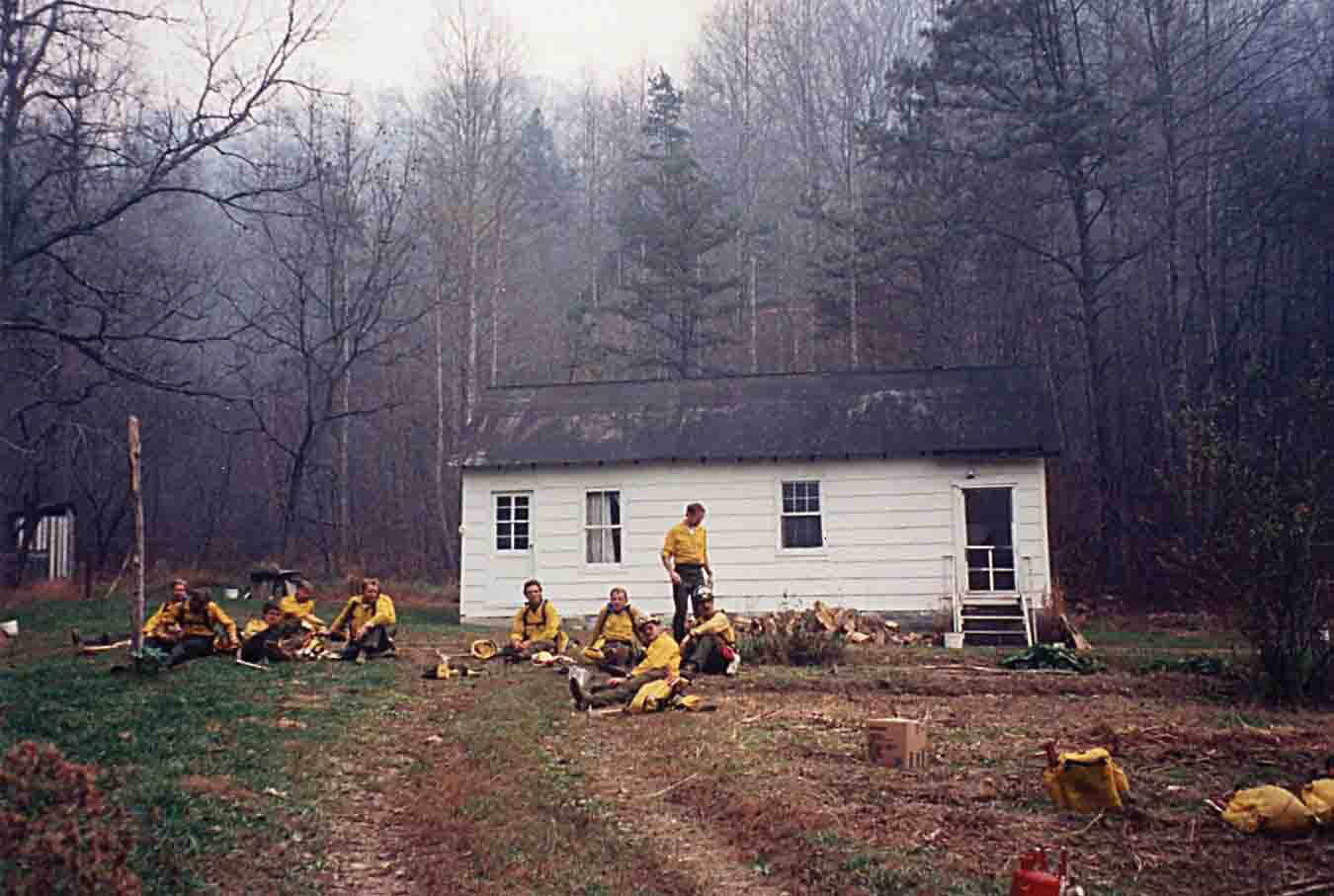
Taking a break after constructing a protective fireline around an old widow’s house ’way back up a holler in the Daniel Boone National Forest in Kentucky.
Afterwards
Once you have reached safety, try to establish contact with other family members or friends to make sure that they know where you are and to be sure they are also safe. Make contact with officials or volunteers at your site and follow their directions regarding space, food, and any amenities available. Offer your assistance, if you can, in helping others get situated.
Make sure your phone or other communication device is operational.
Keep watch on media sources for updates, notices, or clearances to return to your home. Those notices will be aired on various media and will be issued as soon as it is deemed safe by authorities to return.
If you are in an area that is housing many people, try to obtain any supplies that you need, then offer to help others who may need assistance.
Be patient. Officials do not want to keep you away from your home any longer than necessary. However, public safety is their main concern. You should be advised when the all clear is given to return home.
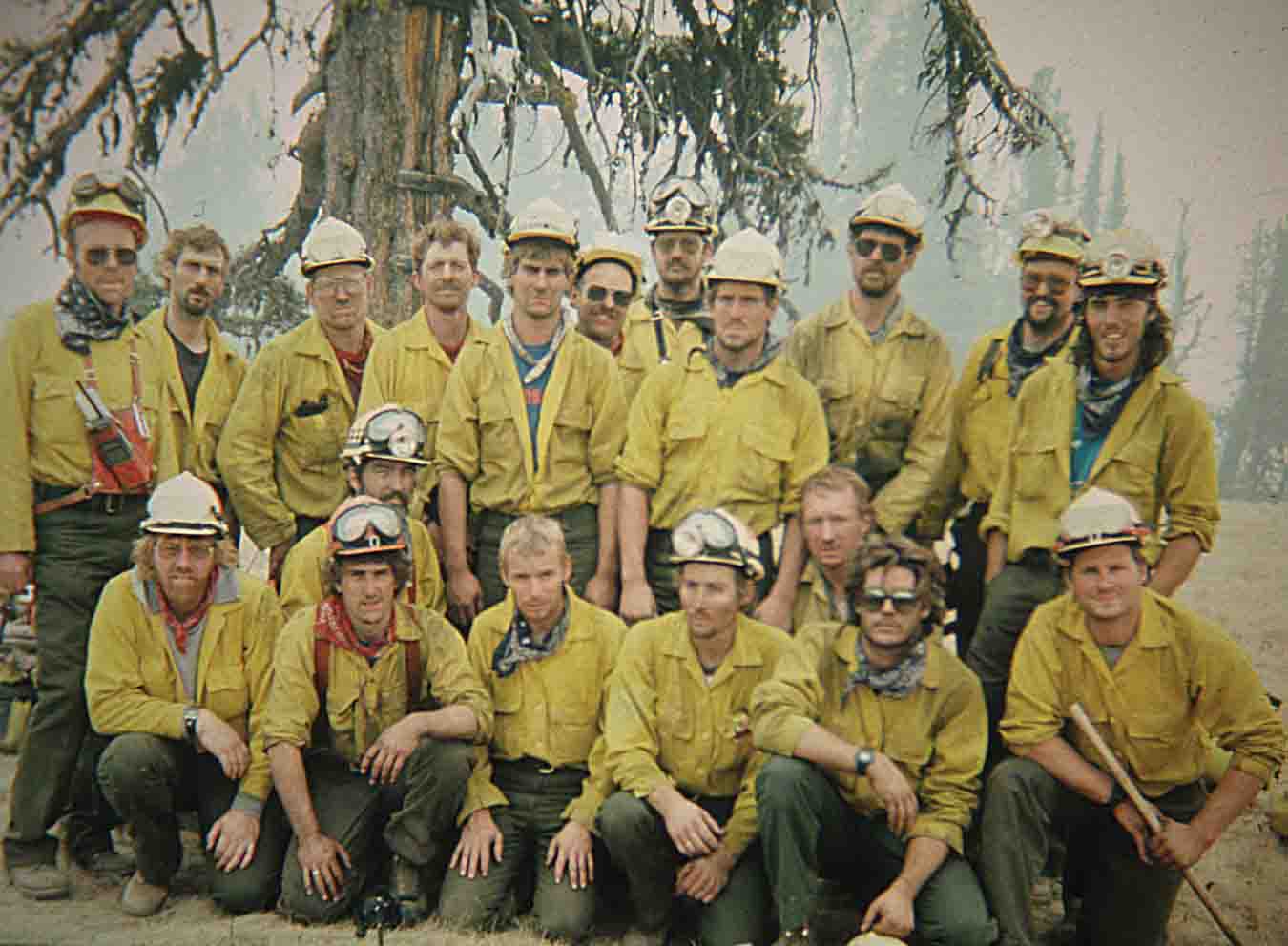
The author and his crew after a nine-day stint of firefighting in the Frank Church River of No Return Wilderness of Idaho. The author is in the back center with the hardhat and headlamp.
Dealing with the aftermath
After a fire, the return to your home is going to be an emotional event. You will be both eager to return, yet dreading to see the result of the passing fire. That is fairly normal.
As you re-enter your home area, be on the alert for downed power lines and other hazards. Watch out for burned snags that might be weakened and ready to fall.
As you arrive home, do a quick size-up.
First, did the home survive the fire? Livestock?
Are there trees or other debris blocking access?
Do a good check of the exterior of your home for any damage to electrical lines or connections.
Check for any possible smoldering fuel sources that might re-ignite.
Before you turn on any gas source, check the propane lines, tanks, or regulators.
Once you have gotten back into your home, check with neighbors to see if they need help in doing the same.
You will be needing to be in contact with your insurance companies, and perhaps with water, gas, and electric companies to get everything back on line. If you have any doubt about the safety of any of your utilities or that of your structure, contact the respective utility or fire officials for guidance.
Recovering from a wildfire can be a traumatic event in itself. Don’t be afraid to ask for assistance, or to offer the same.
Life in the wildlands doesn’t have to be one of constant fear or blissful ignorance. By preparing for wildfires, you are simply covering your homestead with an extra blanket of insurance. In summation, be prepared.
Now retired, the author was employed for over 40 years with the Indiana Department of Natural Resources, with more than 37 years as an Indiana Conservation Officer. Over the decades, he has been detailed on many wildfires in Idaho, Minnesota, Montana, Oregon, Wyoming, Kentucky, and in his home state of Indiana.

